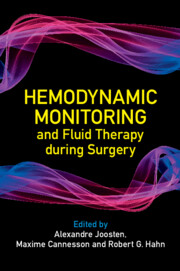Book contents
- Frontmatter
- Contents
- List of Contributors
- Foreword by Jean-Louis Vincent
- Preface
- Section 1 Hemodynamic Monitoring in the Perioperative Period
- Section 2 Basic Science & Concepts in Fluid Therapy
- Section 3 Practical Use
- 11 Outcome and Organ Dysfunction after Major Surgery
- 12 Perioperative Goal-Directed Hemodynamic Therapy
- 13 Fluid Responsiveness Assessment
- 14 Intra-Abdominal Surgery
- 15 Fluid and Hemodynamic Monitoring in Pulmonary Surgery
- 16 Fluid Management in Cardiac Surgery
- 17 Fluid and Hemodynamic Monitoring in Brain Surgery
- 18 Fluid and Hemodynamic Monitoring in Trauma
- 19 Fluid and Hemodynamic Monitoring in Pediatrics
- 20 Fluid Therapy for Liver and Renal Transplantation
- 21 Fluid and Hemodynamic Monitoring in Burns
- Section 4 Future Directions
- Index
19 - Fluid and Hemodynamic Monitoring in Pediatrics
from Section 3 - Practical Use
Published online by Cambridge University Press: 11 April 2024
- Frontmatter
- Contents
- List of Contributors
- Foreword by Jean-Louis Vincent
- Preface
- Section 1 Hemodynamic Monitoring in the Perioperative Period
- Section 2 Basic Science & Concepts in Fluid Therapy
- Section 3 Practical Use
- 11 Outcome and Organ Dysfunction after Major Surgery
- 12 Perioperative Goal-Directed Hemodynamic Therapy
- 13 Fluid Responsiveness Assessment
- 14 Intra-Abdominal Surgery
- 15 Fluid and Hemodynamic Monitoring in Pulmonary Surgery
- 16 Fluid Management in Cardiac Surgery
- 17 Fluid and Hemodynamic Monitoring in Brain Surgery
- 18 Fluid and Hemodynamic Monitoring in Trauma
- 19 Fluid and Hemodynamic Monitoring in Pediatrics
- 20 Fluid Therapy for Liver and Renal Transplantation
- 21 Fluid and Hemodynamic Monitoring in Burns
- Section 4 Future Directions
- Index
Summary
The main aim of a perioperative fluid therapy is to maintain or normalize the patient’s homeostasis. Small children have higher fluid volumes, metabolic rates and fluid needs than adults. Therefore, short perioperative fasting periods (formula milk 4 hours, breast milk 3 hours, clear fluids 1 hour) are important to avoid iatrogenic dehydration, hypotension, ketoacidosis and uncooperative behavior. Balanced electrolyte solutions with 1–2.5% glucose are favored for intraoperative maintenance infusion. Glucose- free balanced electrolyte solutions should then be added as needed to replace intraoperative fluid deficits or minor blood loss. Gelatin solutions or hydroxyethyl starch are useful in hemodynamically unstable patients or those with major blood loss, especially when crystalloids alone are not effective and blood products are not indicated. The monitoring should focus on the maintenance or restoration of a stable tissue perfusion.In nonsurgical or postoperative children, balanced electrolyte solutions should be used instead of hypotonic solutions, both with 5% glucose, as recent clinical studies and reviews showed a lower incidence of hyponatremia.
- Type
- Chapter
- Information
- Hemodynamic Monitoring and Fluid Therapy during Surgery , pp. 219 - 227Publisher: Cambridge University PressPrint publication year: 2024

